

| Nottinghamshire's most recent invertebrate arrivals and colonists |
| No 1. Selected Coreidae, Rhopalidae, Scutelleridae and Pentatomidae Bugs |
| ... |
| For entomologists,
the past 15 to 20 years have proved to be exciting times, with the arrival
of a wealth of species new to the UK.
Some species are those, which as youngsters such as myself in the 1970's
and 1980's and with a developing interest in entomology, thought at the
time that it would never be possible to see without purposely
making the trip to some southern corner of the UK or even abroad. Back then we never thought it likely, that some of these species would eventually occur and colonise Nottinghamshire. But in the 1970's and 1980's, we'd never heard of global warming or climate change etc and weren't even aware of it happening, or even likely to happen. In those days, distribution maps (if you found one) were in some old, tatty publication, usually written back in the 1940's and 1950's by someone you imagined wearing Tweed, wearing a hat and smoking a pipe. But those old maps were all most of us ever had to go on and in those days you thought that species distribution was 'set in stone' - nothing spread north and nothing declined south. But some new species did arrive around that time, although today's younger entomologists and naturalists probably fail to appreciate that in those days, you never found out about it, as the latest national information (and there was very little of that) would be many months out of date by the time your preferred choice of entomological publication finally dropped through your letterbox. Its very different now. |
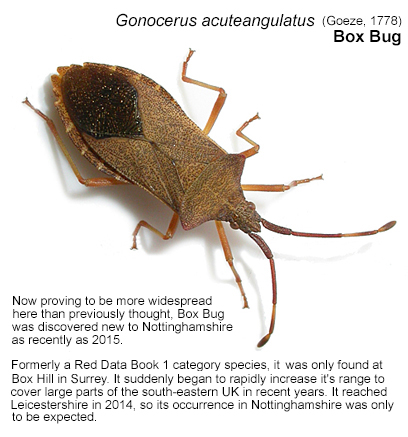 |
|
| ... | ||
|
Some recent arrivals to Nottinghamshire and
colonisation The number of new arrivals and additions to the UK's fauna, has been hastened by changes to the UK's climate - the general rise in temperature, milder and often wetter Winters and generally warmer Summers. And while not all believe that climate change is totally man made, man clearly has been responsible for the spread of many species worldwide, largely through accidental importation through a number of industries. |
||
| ... | ||
|
Horticulture is one such industry, but
importation of fresh food, cut flowers, timber and other resources from
across the world, have all played a part in adding to the UK fauna. For
those with little interest in invertebrates, it will probably come as a surprise to find out that
there are numerous Australian and Asian species now quite happily at home
here. Of course climatic changes obviously also apply to Nottinghamshire and its especially noticeable to those over 40 or 50 years of age. While such changes are potentially catastrophic to many species, there's always an opposing viewpoint and that's what we are experiencing today in the form of species moving north and into the county. At the moment, we are certainly gaining many more species than we appear to be losing. |
||||||||||||||
| ... | |||||||||||||||
|
Species origins But new species don't always come from across the world or the English Channel. Many species suddenly find that climatic changes produce optimum conditions for an increase in population and a northward range expansion, which sooner or later, includes Nottinghamshire. The above list of Hemiptera, all of which are selected from the Families Coreidae, Rhopalidae, Scutelleridae and Pentatomidae, represent just six species all recently recorded new to Nottinghamshire since 2000. There are more which could have been included, but they can be left for another time. Not all those species turning up here via whatever route, go on to colonise parts (or all) areas of the county within a few years. Indeed, it seems that after their initial arrival and usually several years of further records, some species show a decline in numbers or the number of records. Possibly, populations settle to a level that is sustainable within the available habitat, or is it that they just become ignored by recorders? Species often tend to be less recorded once they have increased and become common. |
|
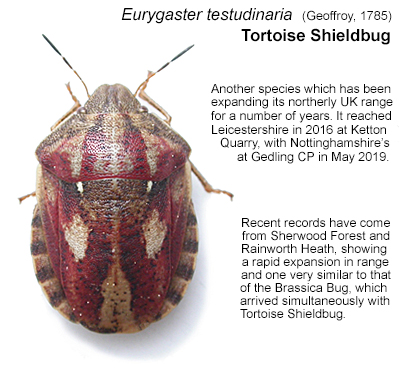 |
| ... |
|
But many species are not so obvious to record. This can either be through size, dull
colouration or specific habitat requirements and so are harder to find and
record. As a consequence, some species can appear to go 'missing' for a
number of years, after their first Nottinghamshire record.
Of those larger Bugs which have colonised Nottinghamshire in the past 15-20 years, now seems a good time to check on their progress. For Tortoise Shieldbug and Brassica Bug, any progress is only within the past two years (including this year) but even so, both species have showed an increase in range nonetheless. Species summaries and distribution In the following species distribution maps, the locations of each species' first three records are numbered in red. As would be expected from species moving into Nottinghamshire from southern counties, most early records are from areas in the south of the county and around Nottingham. But not all species new to Nottinghamshire turn up in this manner. Bear in mind that the maps may be slightly out of date if you are viewing this page after 2021. |
|
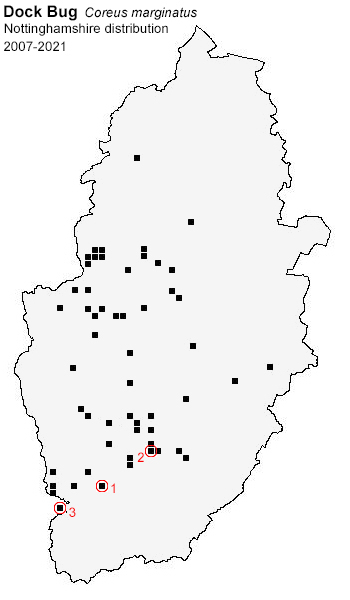 |
||||||
| ... | |||||||
|
First Nottinghamshire records: First recorded at Nottingham University in 2007 (Recorder unknown), with no other records until found at Netherfield Lagoons in 2012 (Netherfield Wildlife Group). It was recorded from Beeston Sidings in 2013 (Bryce, M.), with evidence of local colonisation after being found at nearby Toton Washlands and Trent Meadows in 2014 (Bryce, M.). A single record from Toton Sidings in 2015 (Plant, S.), was the only report from that year, with a handful of records coming in 2016 and which included a first record away from the Trent Valley, from a recreation ground on Valley Road near to Nottingham City Hospital. Dock Bug records really increased from 2017 and it soon became obvious that movement into Nottinghamshire was from the south-west and up through the Trent Valley. It reached Newark by October 2018, found on the wall of Newark Hospital and by then, was being regularly recorded from a number of suburban sites north of the City of Nottingham and in the Market Warsop and Sherwood Forest area of the county. We found it at Hundred Acre Wood just north of Worksop in 2018, which remains the most northerly Nottinghamshire record to date, although by October 2020 it is clearly found throughout the county but just not being recorded. |
|||||||
|
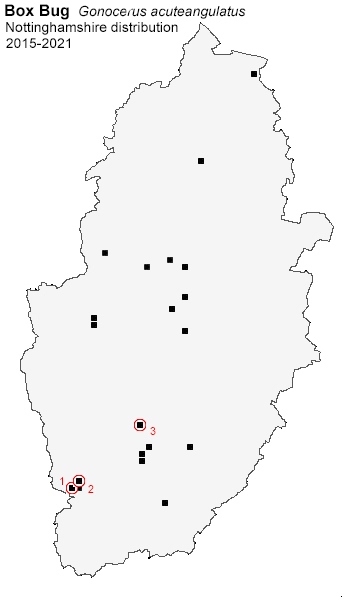 |
||||||
| ... | |||||||
|
Latest known distribution (to October 2020): A strange distribution map. The three northern-most records are all recent (September 2020) and did come as a surprise, considering how long Box Bug has been in the county. For some reason it has been missed and this could possibly be down to its more arboreal nature. Visual searching of known hostplants, or beating hostplants growing in churchyards, parks and gardens will certainly show that this species has unobtrusively moved north into many parts of Nottinghamshire and is now widespread. First Nottinghamshire records: First county record was from Attenborough NR in April 2015 (Sexton, T.) and it was recorded locally for a number of years by the same observer and also recorded from Attenborough Church in 2019 (Matthews, D.). The first record away from Attenborough, was at Gedling CP later in 2019 (Matthews, D.). Box Bug's arrival into Nottinghamshire has been unusual. For such a large and obvious species, it seems surprising that the number of records didn't take off in the manner of some other species. We looked for it on many occasions, often employing different methods of searching, all meeting with no success. In September 2020 it was recorded from Netherfield Lagoons (Smith, P.) and with deliberate searching was eventually found further north in Nottinghamshire, at two sites in Old Ollerton, then in Churchyards at Edwinstowe, Church Warsop, Wellow, Eakring, Kirklington and Bilsthorpe in late September and early October. Checking on Yew trees growing in each Churchyard proved to be very sucessful and it could be found visually on the foliage with relative ease. |
|||||||
|
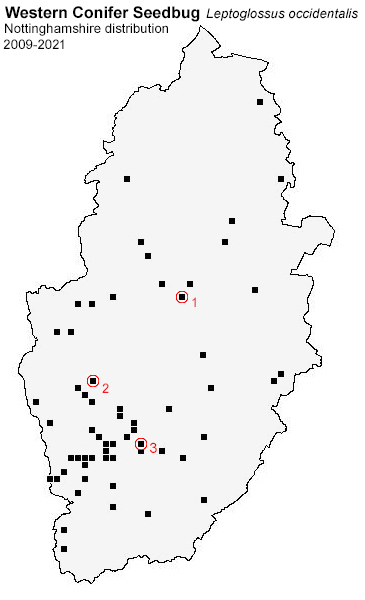 |
||||||
| ... | |||||||
|
Hostplants: Various Pines, with Scot's Pine (Pinus sylvestris) and Douglas Fir (Pseudotsuga menziesii) being particularly favoured. Habitat: Primarily forested areas, where it can be a pest of commercial Pine plantations, but the number of records from urban areas might suggest that Pines growing in urban parks and gardens are also favoured. Latest known distribution (to October 2020): Not confirmed as having bred (or breeding) in Nottinghamshire, but it must be considered very likely with the number of county records. The most northerly record is currently from Beckingham. First Nottinghamshire records: Because this is a large and obvious species and with a tendency to overwinter in buildings, the Western Conifer Seed Bug is a well recorded species and regularly reported by the public. Nottinghamshire's first record was from the bedroom of a house at Eakring on September 27th 2009 (Worthington, M. and Worthington, D.). The following year, there was a record from Hucknall (recorder unknown) and then one on the wall of a house at Carlton in 2011 (Dutton, A.). As of October 2020, there have been approximately 72 Nottinghamshire records, with 41 of these coming in 2018 (28) and 2019 (13) respectively. The majority of the county's records have come from urban and suburban areas of Nottingham. This is also mirrored in the records of Western Conifer Seed Bug from neighbouring counties. Away from Nottingham, all other Nottinghamshire records are very much isolated occurrences, but all have been found near houses or other buildings. |
|||||||
|
 |
||||||
| ... | |||||||
|
Habitat: Occurs along woodland rides and the edges of woodland, along hedgerows, brownfield sites and the untidy corners and edges of arable fields. There are occasional records from urban and suburban gardens. Latest known distribution (to October 2020): Widespread in Nottinghamshire, but despite its bright red colouration, has never been found in the numbers of some of the other species dealt with here. There is nothing to suggest that it is not present throughout Nottinghamshire, but it surprising that it is not reported by the public more often. First Nottinghamshire records: By 2012, Corizus hyoscyami had already been found several times in neighbouring Leicestershire and we were unaware at the time that it had already been recordedin Nottinghamshire the year before, being photographed at Shelford on April 20th 2011 (Dutton, A.). It wasn't until 2013 that it turned up in a Southwell garden on August 8th 2013, with another found in Beeston by a member of the public and taken to Attenborough NR for identification (per Sexton, T.). To date, there have been around 50 Nottinghamshire records. |
|||||||
|
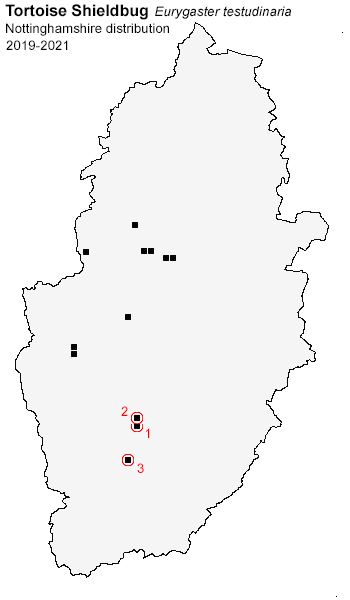 |
|||||||
| ... | ||||||||
|
It is probably just coincidence that all five
Nottinghamshire records form an almost perfect north/south line through
much of the county, as the hostplants are hardly restricted. But this is
a species which is hardly conspicuous through its colouration, despite
its relatively large size and is probably going to pass unrecorded at
many sites unless specifically looked for. First Nottinghamshire records: This is another species which has increased its UK range in recent years. It was previously only found in southern parts of the UK, but spread north to reach Leicestershire in 2016. Nottinghamshire's first records didn't come until 2019, when found at Gedling CP on May 23rd (Matthews, D.), Gedling CP again six days later on May 29th (Tyler, M.) and then a record from Colwick CP on September 14th. In 2020, there were records from Sherwood Forest CP on May 14th and along the access road to Rainworth Heath on September 9th, so this species has showed some increase in range locally. |
||||||||
|
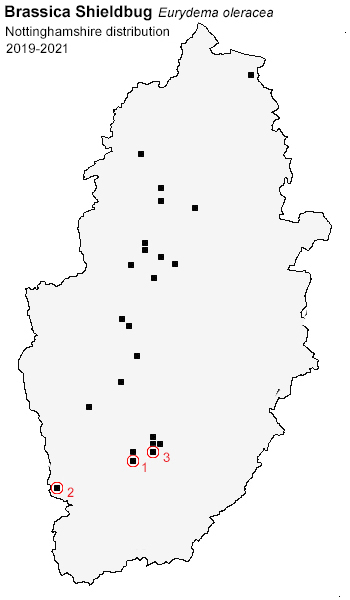 |
||||||
| ... | |||||||
|
First Nottinghamshire records: Another species which had been spreading steadily north from southern counties of the UK for a number of years, but progress seemed to slow following Leicestershire's first records in 2015 and Lincolnshire's first in 2016. Presumably, this range expansion was due to changes in the UK's climate. Nottinghamshire's first records came in 2019, when adults were recorded from Colwick Racecourse on May 16th and Colwick CP on May 19th (Matthews, D.), Netherfield Lagoons (Smith, P.) and then at Toton on June 27th (Lygo, B.). 2020 saw records from further north in Nottinghamshire, being found at both Centre Parcs and Sherwood Forest CP in May and then turning up at nearby Budby South Forest on August 31st. September saw further records from along the access road to Rainworth Heath and on the site of Nottingham City Council Recreation Department's former plant nursery at Bulwell Hall. |
|||||||